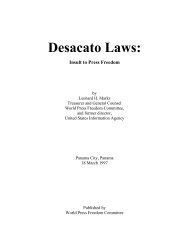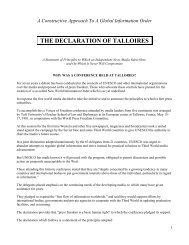Beijing Olympics 2008: Winning Press Freedom - World Press ...
Beijing Olympics 2008: Winning Press Freedom - World Press ...
Beijing Olympics 2008: Winning Press Freedom - World Press ...
You also want an ePaper? Increase the reach of your titles
YUMPU automatically turns print PDFs into web optimized ePapers that Google loves.
<strong>Beijing</strong> <strong>Olympics</strong> <strong>2008</strong>: <strong>Winning</strong> <strong>Press</strong> <strong>Freedom</strong><br />
46<br />
Of all the world’s great metropolises, <strong>Beijing</strong> has the worst water problem. <strong>Beijing</strong> is said<br />
to need annually 1 billion cubic meters of water more than it has. The government<br />
undertook an emergency water supply program for the <strong>Olympics</strong>. It transferred 600<br />
million cubic meters from the Yellow River to Lake Baiyangding in Hebei Province. Then, 1<br />
billion cubic meters was transferred from the four reservoirs of Hebei to <strong>Beijing</strong>. In fact,<br />
the water shortage in the neighboring provinces of Hebei, Shanxi, Shaanxi, and Henan is<br />
more worrisome than <strong>Beijing</strong>’s shortfall.The transfer of 1.6 billion cubic meters from Hebei<br />
to <strong>Beijing</strong> surely risks creating great difficulties or worse for that province.<br />
<strong>Beijing</strong>’s natural water supply conditions are in fact not so bad. Average annual rainfall in<br />
<strong>Beijing</strong> is 625 millimeters - slightly more than for Paris, Berlin, Moscow or Warsaw. The<br />
population density of those capitals is about the same or even somewhat more than<br />
<strong>Beijing</strong>’s and nobody says that they face water shortages.<br />
A UNESCO study sets a criterion to determine whether the natural environment of an<br />
urban zone is arid or not. It is based on the volume of surface flow of the local water<br />
courses. If it is more than 150 millimeters, the natural ecological system can bear the<br />
strain of human activity. In <strong>Beijing</strong>, the flow is 243 millimeters, so conditions are relatively<br />
good. But only 39 per cent of the annual rainfall is counted in that flow, while in Germany<br />
80 per cent is counted in calculating local water resources. If the German calculation<br />
method were used, the water flow in <strong>Beijing</strong> would be 500 millimeters. This shows that<br />
the Chinese capital’s natural water “shortage” is more a question of definition than reality.<br />
In fact, one of the main reasons <strong>Beijing</strong> was chosen as the capital is that its water supply<br />
was good. <strong>Beijing</strong> faces the Yanshan mountain chain and a plain, and numerous rivers<br />
cross the capital. One traditional history says of <strong>Beijing</strong>: “There are rivers and lakes<br />
everywhere, springs spouting pure water and humid soil.” Many place names in the city<br />
are water-related. <strong>Beijing</strong> is surrounded by lakes, rivers and streams. If not for the rivers,<br />
China’s emperors would not have chosen <strong>Beijing</strong> for their capital.<br />
The Yongding is the main river crossing <strong>Beijing</strong>. The Guanting Reservoir, with a capacity of<br />
4.16 billion cubic meters, is on it. The Chaobai River is another of the capital’s major water<br />
courses, with the Miyun Reservoir, whose capacity is 4.375 billion cubic meters. The two<br />
reservoirs could supply more than 2 billion cubic meters annually, satisfying most of<br />
<strong>Beijing</strong>’s needs. Yet the Yonding River has been shrinking since the 1960s.The Guanting<br />
Reservoir used to get 1.41 billion cubic meters annually, compared to .3 billion cubic<br />
meters now. If one also considers water pollution, Guanting’s water can no longer serve<br />
as the capital’s source of drinking water. The Miyun Reservoir’s annual inflow has declined<br />
from 1,49 billion cubic meters to .6 to .8 billion.In 2003, <strong>Beijing</strong> used 3.58 cubic meters,<br />
of which only .85 billion cubic meters came from surface waters and the rest from<br />
underground water sources. The calculation is simple: the Yongding and Chaobai Rivers<br />
have lost 2 billion cubic meters in annual water flow. The Nanshuibeidiao (“bringing<br />
southern waters to the north”) Project is planned to transfer 1.7 billion cubic meters of<br />
water to <strong>Beijing</strong> - not enough to cover the annual shortfall of the two main rivers.<br />
Why have those two rivers lost so much water? It is because they have been overused.<br />
The government’s construction of the Guanting Reservoir on the Yongding was no





